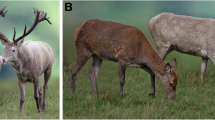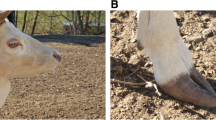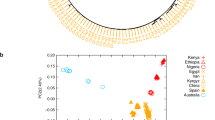Abstract
Three genes, Mc1r, Agouti, and CBD103, interact in a type-switching process that controls much of the pigmentation variation observed in mammals. A deletion in the CBD103 gene is responsible for dominant black color in dogs, while the white-phased black bear (“spirit bear”) of British Columbia, Canada, is the lightest documented color variant caused by a mutation in Mc1r. Rare all-white animals have recently been discovered in a new northeastern population of the coyote in insular Newfoundland and Labrador, Canada. To investigate the causative gene and mutation of white coat in coyotes, we sequenced the three type-switching genes in white and dark-phased animals from Newfoundland. The only sequence variants unambiguously associated with white color were in Mc1r, and one of these variants causes the amino acid variant R306Ter, a premature stop codon also linked to coat color in Golden Retrievers and other dogs with yellow/red coats. The allele carrying R306Ter in coyotes matches that in the Golden Retriever at other variable amino acid sites and hence may have originated in these dogs. Coyotes experienced introgression with wolves and dogs as they colonized northeastern North America, and coyote/Golden Retriever interactions have been observed in Newfoundland. We speculate that natural selection, with or without a founder effect, may contribute to the observed frequency of white coyotes in Newfoundland, as it has contributed to the high frequency of white bears, and of a domestic dog-derived CBD allele in gray wolves.


Similar content being viewed by others
References
Anderson TM, vonHoldt BM, Candille SI, Musiani M, Greco C, Stahler DR, Smith DW, Padhukasahasram B, Randi E, Leonard JA, Bustamante CD, Ostrander EA, Tang H, Wayne RK, Barsh GS (2009) Molecular and evolutionary history of melanism in North American gray wolves. Science 323:1339–1342
Betts MJ, Russell RB (2003) Amino acid properties and consequences of substitutions. In: Barnes MR, Gray IC (eds) Bioinformatics for Geneticists. Wiley, New York, pp 289–316
Blake J (2006) Coyotes in insular Newfoundland: current knowledge and management of the islands newest mammalian predator. Department of Environment & Conservation, Wildlife Division. Available at http://www.env.gov.nl.ca/env/publications/wildlife/51f40a0ed01.pdf
Candille SI, Kaelin CB, Cattanach BM, Yu B, Thompso DA, Nix MA, Kerns JA, Schmutz SM, Millhauser GL, Barsh GS (2007) A β-defensin mutation causes black coat color in domestic dogs. Science 318:1418–1423
Chambers SM (2010) A perspective on the genetic composition of eastern coyotes. Northeastern Naturalist 17:205–210
Clement M, Posada D, Crandall KA (2000) TCS: a computer program to estimate gene genealogies. Mol Ecol 9:1657–1659
Evert RE, Rothuizen J, van Oost BA (2000) Identification of a premature stop codon in the melanocyte-stimulating hormone receptor gene (MC1R) in Labrador and Golden retrievers with yellow coat colour. Anim Genet 31:194–199
Hedrick PW (2009) Wolf of a different colour. Heredity 103:435–436
Hedrick PW, Ritland K (2011) Population genetics of the white-phased “spirit” black bear of British Columbia. Evolution 66:305–313
Hoekstra HE (2006) Genetics, development, and evolution of adaptive pigmentation in vertebrates. Heredity 97:222–234
Kays RW, Gompper ME, Ray JC (2008) Landscape ecology of eastern coyotes based on large-scale estimates of abundance. Ecol Appl 18:1014–1027
Kays R, Curtis A, Kirchman JJ (2010) Rapid adaptation evolution of northeastern coyotes via hybridization with wolves. Biol Lett 6:248–249
Leonard BC, Marks SL, Outerbridge CA, Affolter VK, Kananurak A, Young A, Moore PF, Bannasch DL, Bevins CL (2012) Activity, expression and genetic variation of canine β-defensin 103: a multifunctional antimicrobial peptide in the skin of domestic dogs. J Innate Immunol 4:248–259
Majerus MEN, Mundy NI (2003) Mammalian melanism: natural selection in black and white. Trends Genet 19:585–588
Marklund L, Moller MJ, Sandberg K, Andersson L (1996) A missense mutation in the gene for melanocyte-stimulating hormone receptor (MC1R) is associated with the chestnut coat color in horses. Mamm Genome 7:895–899
Marshall HD, Ritland K (2002) Genetic diversity and differentiation of Kermode bear populations. Mol Ecol 11:685–697
Maunder JE (1982) The Newfoundland wolf. Osprey 13:36–49
McGrath M, Dredge M, Curran R, Reynolds J (2010) Harvest providing valuable insight into coyote ecology. News from the Wildlife Division 6:1–3. Department of Environment & Conservation, Natural Heritage Branch. Available at http://www.env.gov.nl.ca/env/publications/wildlife/our_wildlife_fall_2010.pdf
Moffett S, Mouillac B, Bonin H, Bouvier M (1993) Altered phosphorylation and desensitization patterns of a human beta 2-adrenergic receptor lacking the palmitoylated Cys341. EMBO J 12:349–356
Mundy NI (2005) A window on the genetics of evolution: MC1R and plumage colouration in birds. Proc Biol Sci 272:1633–1640
Mundy NI, Kelly J, Theron E, Hawkins K (2003) Evolutionary genetics of the melanocortin-1 receptor in vertebrates. Ann N Y Acad Sci 994:307–312
Nachman MW, Hoekstra HE, D’Agostino SL (2003) The genetic basis of adaptive melanism in pocket mice. Proc Natl Acad Sci USA 100:5268–5273
Newton JM, Wilkie AL, He L, Jordan SA, Metallinos DL, Holmes NG, Jackson IJ, Barsh GS (2000) Melanocortin 1 receptor variation in the domestic dog. Mamm Genome 11:24–30
Parker G (1995) Eastern coyote: the story of its success. Nimbus Publishing, Halifax, Nova Scotia
Ritland K, Newton C, Marshall HD (2001) Inheritance and population structure of the white-phased “Kermode” black bear. Curr Biol 11:1468–1472
Schiöth HB, Phillips SR, Rudzish R, Birch-Machin MA, Wikberg JES, Rees JL (1999) Loss of function mutations of the human melanocortin 1 receptor are common and are associated with red hair. Biochem Biophys Res Commun 260:488–491
Schmutz SM, Berryere TG, Ellinwood NM, Kerns JA, Barsh GS (2003) Mc1r studies in dogs with melanistic mask or brindle patterns. J Hered 94:69–73
Slatkin M (2004) A population-genetic test of founder effects and implications for Ashkenazi Jewish diseases. Am J Hum Genet 75:282–293
Tamura K, Peterson D, Peterson N, Stecher G, Nei M, Kumar S (2011) MEGA5: molecular evolutionary genetics analysis using maximum likelihood, evolutionary distance, and maximum parsimony methods. Mol Biol Evol 28:2731–2739
Våge DI, Lu D, Klungland H, Lien S, Adalsteinsson S, Cone RD (1997) A non-epistatic interaction of agouti and extension in the fox, Vulpes vulpes. Nat Genet 15:311–315
Way JG, Rutledge L, Wheeldon T, White BN (2010) Genetic characterization of eastern “coyotes” in eastern Massachusetts. Northeastern Naturalist 17:189–204
Acknowledgments
We are grateful to Rick Curran and local hunters and trappers for provision, characterization, and cataloguing of specimens. Dr. Edward Miller and Paul Pitts provided assistance with obtaining tissue samples and DNA extraction. Much of the laboratory work, including all the DNA sequencing, was performed in the Genomics and Proteomics Facility of Memorial University of Newfoundland’s CREAIT Network. Dr. Elizabeth Perry of the GaP Facility was available for numerous enlightening discussions about coyotes. Two anonymous reviewers also provided many insightful comments.
Author information
Authors and Affiliations
Corresponding author
Rights and permissions
About this article
Cite this article
Brockerville, R.M., McGrath, M.J., Pilgrim, B.L. et al. Sequence analysis of three pigmentation genes in the Newfoundland population of Canis latrans links the Golden Retriever Mc1r variant to white coat color in coyotes. Mamm Genome 24, 134–141 (2013). https://doi.org/10.1007/s00335-012-9443-x
Received:
Accepted:
Published:
Issue Date:
DOI: https://doi.org/10.1007/s00335-012-9443-x




